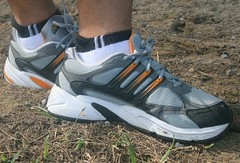Apart from carbohydrates, proteins, fats, roughage and water, vitamins and minerals must also be included in your diet. There are quite a number of vitamins and minerals but according to your syllabus, you only have to know 2 vitamins (vitamins C and D) and 2 minerals (Iron and Calcium).
MINERALS
A. IRON
MINERALS
A. IRON
- The red blood cells contain the pigment haemoglobin which contains iron. This iron plays and important role in transporting oxygen around the body. Millions of red blood cells are broken down each day and their iron is stored by the liver and used to make more haemoglobin. However some iron is lost and adults have to take in about 15mg each day.
- Source of iron: Red meat, liver, kidneys, eggs, groundnuts, bread, spinach and other green vegetables.
- Diet deficient in iron: Anaemia - insufficient haemoglobin resulting in the reduction of the blood's oxygen carrying capacity.
B. CALCIUM
- Calcium (in the form of calcium phosphate) is deposited in the bones and the teeth (hence making them hard). In another way to say, calcium is very important for bones and teeth formation and development.
- Calcium is also present in blood plasma and plays and important role in blood clotting (without calcium, blood clotting becomes less efficient).
- Caclium is also needed for chemical changes which bring about muscle contraction and transmission of nerve impulses.
- Source of Calcium: Any diary products, especially milk.
- Note: Many calcium salts are insoluble in water and may pass through the alimentary canal without being absorbed. For calcium to be absorbed, vitamin D must also be included in your diet. So no point taking in tons and tons of calcium (literally speaking) without taking in vitamin D.
- Diet deficient in calcium may results in rickets (in children) and osteomalacia (in adults).

VITAMINS
A. VITAMIN D
- Vitamin D is a fat-soluble vitamin.
- Vitamin D is relatively resistant to heat and oxidation.
- Source of vitamin D: Fish liver oils, egg yolks, milk and margarine
- Morning Ultraviolet rays in sunlight helps your skin to make vitamin D. So if get enough morning sunlight, you may not need vitamin D in your diet.
- Main functions of vitamin D: Helps in the absorption of calcium (and phosphorus), hence promoting formation and proper development of bones and teeth.
- Deficient: Rickets in children (poor bones and teeth development). In severe cases, the bones may become soft and pliable and are readily bent under the weight. Hence bow legs. In adults, insufficient vitamin D in the diet may results in Osteomalacia (bones become soft and may break easily).
- Excess: Deposition of excess calcium may result in organs like the kidneys and the lungs (calcification).
B. VITAMIN C (ASCORBIC ACID)
- Vitamin C is a water soluble vitamin.
- Source of vitamin C: Citrus fruits and other fruits like papaya, guava, tomatoes and bananas. Fresh green vegetables are also very rich in vitamin C.
- Vitamin C is easily destroyed by heat. So, be very careful not to destroy your source of vitamin C when cooking.
- Functions: Very important for the formation of intercellular substances which are normally found in between the cells (that hold the cells together). Vitamin C is also important for maintaining healthy epithelial tissues.
- Deficient in vitamin C may lead to SCURVY (swollen bleeding gums, loosening of teeth, haemorrhages in the muscles and skin, poor healing of wounds and painful swollen joints)
- Excess: Excreted out from the body. It cannot be stored. So daily intake is necessary.
